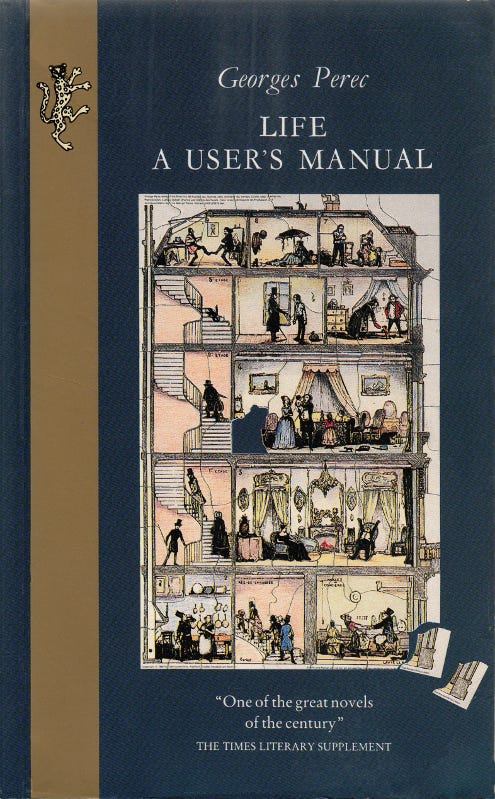Life: Public versus Private, On Display versus Out of Sight
What a Piece of Work I Am, Chapter 21:
“On display,” she said. “An interesting term. An interesting concept. It’s the backside of privacy—to be on display. That was the feeling I had about these people whose rooms I slipped in and out of, and from my point of view it was accurate. Their things and their secrets—some of their secrets anyway—were on display, for me to see.”
Georges Perec, La Vie, Mode d’Emplois (Life, a User’s Manual), translated by David Bellos:
What happens behind the flats’ heavy doors can most often be perceived only through those fragmented echoes, those splinters, remnants, shadows, those first moves or incidents or accidents that happen in what are called the “common areas,” soft little sounds damped by the red woollen carpet, embryos of communal life which never go further than the landing. The inhabitants of a single building live a few inches from each other, they are separated by a mere partition wall, they share the same spaces repeated along each corridor, they perform the same movements at the same times, turning on a tap, flushing the water closet, switching on a light, laying the table, a few dozen simultaneous existences repeated from storey to storey, from building to building, from street to street.
They entrench themselves in their domestic dwelling space—since that is what it is called—and they would prefer nothing to emerge from it; but the little that they do let out—the dog on a lead, the child off to fetch the bread, someone brought back, someone sent away—comes out by way of the landing. For all that passes, passes by the stairs, and all that comes, comes by the stairs: letters, announcements of births, marriages, and deaths, furniture brought in or taken out by removers, the doctor called in an emergency, the traveller returning from a long voyage. It’s because of that that the staircase remains an anonymous, cold, and almost hostile place.
Jacques Tati, PlayTime, Monsieur Hulot inspects the modern apartments:
See also:
Life: Metaphors and Similes for TG 40, TG 55, TG 60; Phases of TG 89; Life and Death TG 92; Yearning for Another, Different, Better TG 100, TG 104; Life: Its Vicissitudes TG 146; Life Imitates Art (More or Less) TG 153; Stages of: Puberty TG 164; Life: The Nature of It, and Ways One Might Live One’s TG 382; Life: Its Vicissitudes, Its Shames and Humiliations, Its Follies, Its Burden of Pain, Care, and Misery TG 376; Attitudes Toward TG 523; Carpe Diem TG 523
Have you missed an episode or two or several?
You can begin reading at the beginning or you can catch up by visiting the archive or consulting the index to the Topical Guide. The Substack serialization of Little Follies begins here; Herb ’n’ Lorna begins here; Reservations Recommended begins here; Where Do You Stop? begins here; What a Piece of Work I Am begins here.
You can listen to the episodes on the Personal History podcast. Begin at the beginning or scroll through the episodes to find what you’ve missed. The Substack podcast reading of Little Follies begins here; Herb ’n’ Lorna begins here; Reservations Recommended begins here; Where Do You Stop? begins here; What a Piece of Work I Am begins here.
You can listen to “My Mother Takes a Tumble” and “Do Clams Bite?” complete and uninterrupted as audiobooks through YouTube.
You can ensure that you never miss a future issue by getting a free subscription. (You can help support the work by choosing a paid subscription instead.)
At Apple Books you can download free eBooks of Little Follies, Herb ’n’ Lorna, Reservations Recommended, and Where Do You Stop?
You’ll find overviews of the entire work in An Introduction to The Personal History, Adventures, Experiences & Observations of Peter Leroy (a pdf document), The Origin Story (here on substack), Between the Lines (a video, here on Substack), and at Encyclopedia.com.



